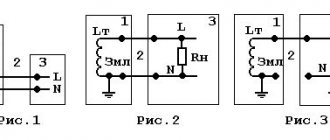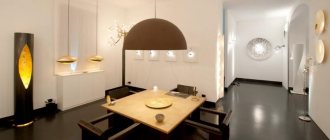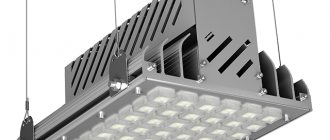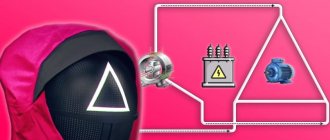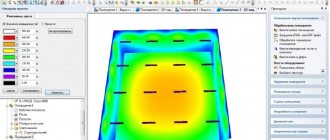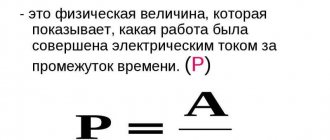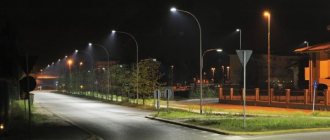Illumination pulsation coefficient in lighting installations. Calculation method.
Light flux pulsations occur when light sources are powered with alternating or pulsed current. A person visually distinguishes pulsations of a light flux with a frequency less than the critical frequency of flicker fusion, lying in the range from 35 to 60 Hz depending on the area of the retina that perceives radiation: for the foveal region, the CFSM is 40...55 Hz, for the parafoveal region it increases to 55... 60 Hz, at the extreme periphery it decreases to 35...40 Hz. Thus, pulsations of the light flux are more noticeable in peripheral vision.
Sergey Kotov
, Graduate of the Department of Lighting Engineering and Light Sources of the Moscow Energy Institute. Design engineer at LLC STK HELIOCITY. Experience in the specialty since 2007. He took part in the implementation of lighting projects for the facilities of OJSC Severstal and OJSC AK Transneft, workshops of the Kaluga Turbine Plant, Kirsinsky Cable Plant, etc.
This article is only a theoretical part, which describes the method for calculating the light pulsation coefficient. The second part of the article is practical and is an online calculator of the illumination pulsation coefficient for a lighting installation on lamps with various light sources.
Pulsations visible to the eye cause obvious irritation, but pulsations of light flux, indistinguishable by the organ of vision, having a frequency of up to 300 Hz, also have a negative effect on visual performance and the nervous system. The most dangerous consequences of high pulsations of light flux include the occurrence of a stroboscopic effect - the illusion of immobility or slow motion of rotating objects, which can lead to work-related injuries. Increased visual fatigue and the risk of injury dictate the need to normalize the luminous flux pulsation coefficient, which ultimately affects the illumination pulsation coefficient at the Kp facility.
What is light ripple factor
This term refers to the relative depth of fluctuations in the illumination of lamps or fixtures that occur during operation of the equipment when it is powered by alternating current. In essence, this is an indicator of changes in brightness, which is inherent in a particular type of equipment and affects the comfort of the work performed. When the regulatory indicators are exceeded, performance decreases, and the longer the pulsation affects vision, the higher the fatigue.
The acceptable value depends on the type of work being performed and the visual strain required in a particular situation. Most standards were established based on the capabilities of lighting equipment used in the middle of the last century. At that time the norms were 10, 15 or 20%, some of them are still used today, others have become stricter and have changed to a lesser extent.
In all rooms where computer equipment is used or displays are installed, the light pulsation rate should not exceed 5%.
The considered coefficient increases if dimmers are used to adjust the brightness of the light. Moreover, changes are observed only in devices whose operation is based on the principle of pulse width modulation. Frequency also matters; if it is below 300 Hz, the effect is especially noticeable.
If the lighting is powered by alternating current with a power frequency of 50 Hz, the ripple frequency is calculated at twice the value, therefore equal to 100 Hz. In this case, it is impossible to visually determine the pulsation. Therefore, special devices are used for control measurements - pulse meters. Most often, this is not a separate device, but universal equipment combined with a lux meter. In 2012, a number of standards were introduced regarding measuring instruments and their verification, so all devices must comply with established standards.
For a workplace with a computer, the pulsation of light is strictly regulated.
How to Convert Luxes to Lumens
However, if you know the required illumination value in lux and the area of the illuminated surface, you can calculate the required luminous flux in lumens. It should be understood that the calculation will be performed with many assumptions, since it is not possible to bring the conditions for its implementation closer to physically ideal ones. When calculating, it should be assumed that:
- the light source is located in the center;
- the illumination is uniform over the entire area, which is practically impossible;
- light falls on the entire surface area at the same angle;
- the surface is illuminated from within the mental sphere supposed to surround the source.
In order to get the value in lumens, you need to multiply the standard in lux by the value of the area that needs lighting.
The floor and ceiling area will be: 10 x 10 = 100 m². Area of each wall: 4 x 10 = 40 m². Theoretically, with the assumption of uniform illumination and the location of the source, equidistant from all points of the surface, the problem is solved as follows: 300 lux x (4 x 40 + 100 + 100) m² = 300 x 360 = 108,000 lm. If this astronomical value is “translated” into ordinary 100-watt incandescent lamps, then you will only need... 72 pieces.
The practical approach will be different. There is absolutely no need to illuminate the ceiling - employee workplaces are located below. Moreover, the design of many ceiling lights makes it impossible for light to spread upward. This means you need to remove the ceiling area from the calculations:
300 lux x 260 m² = 78,000 lumens.
Modern LED ceiling lights can produce 5,000 lumens. Accordingly, 16 pieces (78,000/5000) will be required, rounded to the nearest whole number.
This number can be reduced. According to SanPiN 2.2.1/2.1.1.1278-03, illumination is measured above the working surface, as well as at control points 1 m away from walls and light openings. It is enough to place lighting fixtures above employees’ workplaces. Mathematically reducing the geometric characteristics of the floor by 1 m on each side, we get:
300 lx x (160 + 64) m² = 300 x 224 = 67200 lm. What in the ceiling lights will be: 14 pieces, rounded to the nearest whole number.
Watch this video on YouTube
Standards and requirements for pulsation frequency
It all depends on the type of equipment used and the features of its connection. It is worth noting that the highest rates of light pulsation, exceeding 30%, are characteristic of electromagnetic ballasts and gas-discharge lamps operating from a single-phase line. Therefore, they are most often used for street lighting and places where constant eye strain is not required.
By the way! Contrary to popular belief, pulsation is also inherent in standard incandescent lamps. When they operate from a single-phase power supply, the figure can be up to 15%.
LED equipment requires special attention. The principle of its operation differs from standard options; the indicator depends on the circuit design features of the power supply used in the system. In many cheap products, to reduce cost, a rectified current at an industrial frequency is supplied at the output instead of a constant voltage, which leads to the fact that the ripple can reach 30% .
When purchasing LED equipment, you must definitely request technical documentation from the manufacturer or supplier with all the main indicators, including light pulsation. Moreover, it is necessary to study data on each product separately, even if they are similar in characteristics. It often happens that the performance indicators of two almost identical lamps are very different.
Do not forget that ripple rates increase significantly when using dimmers with a frequency of up to 300 Hz in the system. It is better to use options with indicators exceeding 400 Hz. It is also worth noting that if the power frequency is more than 5 kHz, then flicker indicators are reduced to 1%.
In high-quality LED lamps, ripple indicators are minimal.
This option works especially well with standard and compact fluorescent equipment. Thanks to modern technologies, they can be supplied with power at frequencies above 25 kHz, which allows for minimal flickering of light without additional devices.
The rate of illumination pulsation depends on the light source and the number of phases to which the equipment is connected. The main coefficients for the most common lamps are as follows:
- Incandescent lamps when connected to a single-phase line must provide a flicker coefficient ranging from 10 to 15%, two-phase - from 6 to 8%, three-phase - 1%.
- Fluorescent lamps LB , operating from one phase - 34%, two - 14.4, three - 3%.
- LD fluorescent lamps connected to a single-phase line - 55%, two-phase - 23.3, three-phase - 5%.
- Mercury arc lamps, when operating from single-phase voltage, must provide a flicker coefficient of no more than 58%, two-phase - 28%, three-phase - 2%.
- Metal halide light sources when operating from one phase must comply with the flicker coefficient standard of 37%, two phases - 18%, three phases - 2%.
- sodium lamps operating from a single-phase line - 77%, two-phase - 37.7%, three-phase - 9%.
Sodium lamps have a high pulsation coefficient, so they are used mainly for street lighting.
External characteristics
The external characteristic of the secondary power source is the dependence of the load voltage on the load current: U
=
f(I
).
The secondary power source is usually represented by a constant voltage generator U
0xx (no-load) with internal resistance
R
out. This diagram is shown in Figure 4.
Using this diagram, you can determine the voltage at the power supply terminals: U
=
U
0xx −
I R
out. A typical external characteristic of a power supply is shown in Figure 5 and usually has a falling character.
The voltage drop is determined by the output resistance of the power supply, so you can determine its output resistance by its external characteristic:
This resistance is usually nonlinear, so it is found at a given operating current. For a stabilized power supply, the output resistance can be quite small, and then the external characteristic takes the form shown in Figure 6.
The output impedance of the power supply significantly affects the operation of the REA. If several units are powered from one source (a widespread practice), then the dependence of the output voltage on the source current at Rout≠0 leads to electrical communication between several loads. This situation is illustrated by the equivalent circuit shown in Figure 7.
Causes of the stroboscopic effect
The stroboscopic effect is a phenomenon of distortion of the perception of moving or rotating elements of equipment. This can often be seen on a rotating lathe pulley, under certain conditions it creates the illusion that it is standing still or spinning in the opposite direction. The phenomenon is observed in cases where the frequency of the alternating current powering the lamp is a multiple of the rotational speed of the equipment or mechanisms.
Most often, such phenomena can be observed in industrial premises illuminated by fluorescent lamps. In fact, due to the variable supply of electricity, it turns out that the period of turning the lamp on and off is superimposed on the periodicity of the rotation of the mechanism.
For safety reasons, all production areas were previously lit with incandescent lamps, as they have a much lower flicker rate, which minimized the risk of stroboscopic effects. In modern conditions, LED lamps have become the best solution, but only if high-quality equipment is used with power supplies that supply direct current.
An example of the stroboscopic effect low-quality LED lamps can produce.
Unit
Illumination is the luminous value that is equal to the flux of light incident on a surface to its area. It is considered directly proportional to the light source. Differs in uniform distribution on the area. It is found by dividing the candela luminous intensity by the distance to the light source and multiplied by the cosine of the angle of incidence of the sun's rays.
Note! It is measured according to the international classification system in lux, which is equal to ten photos or one lumen per square meter. Therefore, the unit of illumination measurement is lux
It is worth noting that it can be converted to candela and watt.
Basic unit of measurement lux
Candela
Candela, translated from English as candle, is a unit of measurement of the intensity of a light source according to the International Unit System. It was formed in 1979. Equal to 540⋅1012 Hz or 683 lm/W. Various light sources are measured in candelas, for example, an incandescent lamp with a candle, a super-bright LED, a fluorescent lamp and the sun. Addition: the approximate solar power in candelas is 2.8⋅10, which translates into watts of 3.83⋅1026
Candela
Lumens and Luxes
A lumen is a unit of measurement that is equal to the flux of sunlight emitted by a source, equal to a candela and a steradian. The entire light flux is measured in lumens, but the calculation does not take into account the strength of the lens with reflectors, so the resulting indicator is not a direct parameter for assessing the brightness with the efficiency of the source.
Lux is the SI measuring subunit of lumen. Unlike lumen, lux gives an estimate of the luminous flux that falls per square meter. The same gives an understanding of what luminous flux the light source has.
Note! That is, lux is a characteristic that allows you to find out the efficiency of a lamp in a specific area. To better understand their main difference, it is worth considering the figure
It clearly shows how as the height increases, the lighting expands and how the brightness decreases
To better understand their main difference, it is worth considering the figure. It clearly shows how as the height increases, the illumination expands and how the brightness decreases.
Lumen and lux as a measurement unit
Lumen and Watt
As stated above, a lumen is the full amount of light from a light source. Watt is an indicator of how much power, heat flux, sound energy and total power of electric current or radiation a device has. One watt equals 100 lumens. The translation can be done independently using special formulas or with the assistance of calculators. Often all the necessary indicators are given on the device itself.
It is worth noting that modern LEDs have the best performance. They have high brightness, harmonious spectral distribution, durability, and resistance to various types of influences. Interestingly, if we take devices with the same illumination, they will consume ten times less electrical energy than incandescent lamps.
Note! Considering the actual service life and reduced operating investment costs, the purchase of these products will be economically feasible. Converting lumens to watts
Converting lumens to watts
Multiples of units
For convenience, lumen units are disassembled into parts. So, there are kilolumens, megalumens and gigalumens. There are 1000 lumens in one kilolumen, 1000000 in a megalumen, and 1000000000 in a gigalumen. There are also other quantities with the prefixes deca, hecto, tera, peta, exa, zetta and iotta.
Submultiple units
The same approach applies to submultiple values. The basic ones are millilumens, microlumens and nanolumens, which are equal to 10 to the −3 power, 10 to the minus 6 power and 10 to the minus 9 power. There are also the prefixes deci, santi, pico, femto, atto, zepto and iokto. It is worth noting that submultiples, as well as multiples, are used only in professional settings and when performing physical tasks. In real life, illumination measures and other parameters are not used for calculations.
The influence of pulsations on the human body
This phenomenon was noticed quite a long time ago; the most extensive studies were carried out in the middle of the last century. According to the results, any light pulsation with a frequency of up to 300 Hz has a negative effect on the human body .
If you constantly stay in a room with poor quality light, your daily hormonal rhythm will change. In addition, if the flicker has a frequency of up to 120 Hz, the human brain reacts to constant changes and constantly tries to process incoming information on a subconscious level.
Due to prolonged stress, people get tired much faster and more severely. Concentration is lost, mental abilities are reduced. This also affects those who are engaged in intellectual work - due to the high load on the brain, making decisions and conducting research is much more difficult, and efficiency decreases significantly.
If the flicker exceeds 300 Hz, it does not affect people in any way and does not overload their brain. It is worth focusing on this indicator when choosing equipment.
Ways to reduce lighting pulsation
There may be several solutions to this. It all depends on the characteristics of the room and the type of devices used; the following methods are most often used:
- Connecting lamps to a two- or three-phase line alternately. Due to the shift, the voltage is applied unevenly and flicker is reduced.
- When powered from a three-phase line, the number of lamps must be a multiple of three, and when powered from a two-phase line, the number must be a multiple of two.
- Replacement of outdated equipment with modern LED equipment.
- Use of fluorescent lamps with a modern power supply of 5 kHz or higher.
The video discusses the impact of light pulsations on the safety of road users.
It is necessary to control the pulsation of lighting. It affects the comfort of a person’s stay, his fatigue, and in industrial premises safety depends on this indicator.
SanPiN 2.2.1/2.1.1.1278–03 and SP 52.1333.2011
In Russia, requirements for lighting quality are regulated by regulatory documents. In particular, SanPiN 2.2.1/2.1.1.1278–03 establishes hygienic requirements for lighting in residential and public buildings. In living rooms, LED lamps must provide an illumination level of at least 150 Lux. The pulsation coefficient is not standardized. In public non-industrial buildings, sanitary standards set the Kp value within 10-20%.
In the set of rules SP 52.1333.2011, much attention is paid to the standards of artificial lighting of all types of structures, residential areas and production sites. The regulatory document separately stipulates the requirements for LED light sources. Depending on the degree of work intensity, it shows the permissible values of the pulsation coefficient and illumination.

